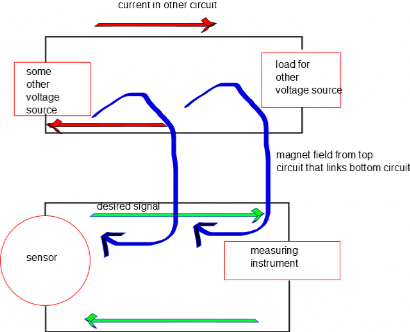US Patent 7,791,353 B2
Introduction
Simple Circuit Concepts
Transmission lines
Faraday's law
Near and far fields
Spurious coupling mechanisms
- Direct conduction
- Capacitive coupling -problem
- Capacitive coupling -fixing
- Inductive coupling-problem
- Inductive coupling -fixing by twisted
- Inductive coupling -fixing by coax
- Electromagnetic pickup
- Examples
- Safety & star grounding
- Gnd loop resistance, inductance
- Low frequency behavior
- High frequency behavior
- Troubleshooting
- Methods for removing
Spurious coupling via inductive pickup: the problem
Again, consider a signal circuit consisting of a sensor connected via conductors to a measuring instrument, but now, as shown in Fig. 7, there also exists some physically separate external circuit involving current-carrying conductors. The current in the external circuit is shown as red and the magnetic field produced by this current is shown as blue. In general some fraction of this external circuit magnetic field links the signal circuit consisting of sensor and measuring instrument. The linked magnetic flux F is the product of the linked magnetic field (blue) and the area enclosed by the conductors comprising the sensor/measuring instrument circuit. Faraday's law states that the time derivative of this flux produces a voltage that adds to the voltage produced by the sensor. The spurious voltage will drive a current that adds to the desired signal current, shown as green. This coupling mechanism is essentially a transformer where the top circuit forms the primary and the bottom circuit forms the secondary. This form of spurious coupling is an issue in low impedance AC circuits because such circuits have large time-dependent currents.
Again, consider a signal circuit consisting of a sensor connected via conductors to a measuring instrument, but now, as shown in Fig. 7, there also exists some physically separate external circuit involving current-carrying conductors. The current in the external circuit is shown as red and the magnetic field produced by this current is shown as blue. In general some fraction of this external circuit magnetic field links the signal circuit consisting of sensor and measuring instrument. The linked magnetic flux F is the product of the linked magnetic field (blue) and the area enclosed by the conductors comprising the sensor/measuring instrument circuit. Faraday's law states that the time derivative of this flux produces a voltage that adds to the voltage produced by the sensor. The spurious voltage will drive a current that adds to the desired signal current, shown as green. This coupling mechanism is essentially a transformer where the top circuit forms the primary and the bottom circuit forms the secondary. This form of spurious coupling is an issue in low impedance AC circuits because such circuits have large time-dependent currents.

Find ground loops fast!
-eliminate electical interference, fix star grounding
-eliminate electical interference, fix star grounding
US Patent 7,791,353 B2
Figure 7 Magnet field (blue) produced by current (red) in top circuit links bottom circuit. The time derivative of the linked flux (magnet field times area) produces a voltage in the bottom circuit. This spurious voltage adds to the voltage from the sensor and so adds to the desired signal current (green).
For quotes, purchase orders, shipping outside USA, questions contact
Circuit Insights LLC, Pasadena, California, USA
Email: sales@loopslooth.com Tel: 626-201-0488